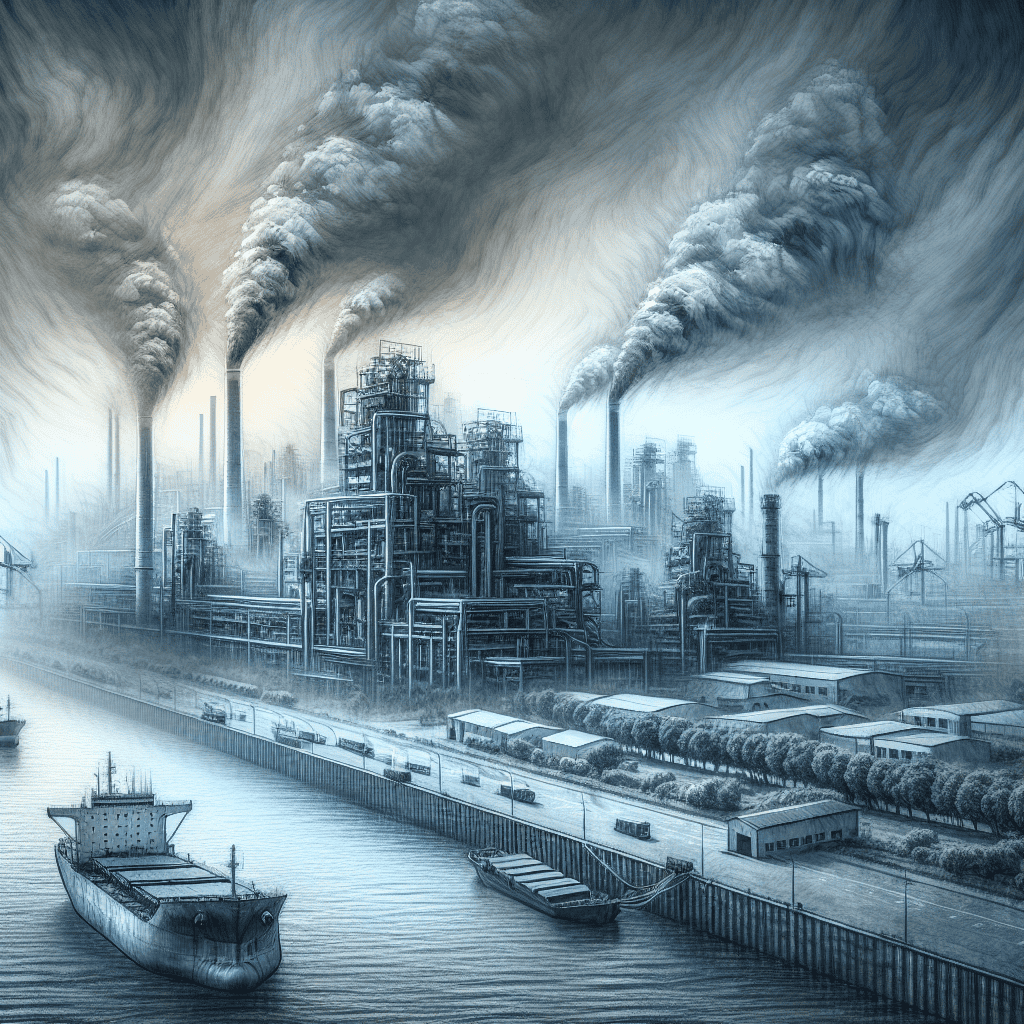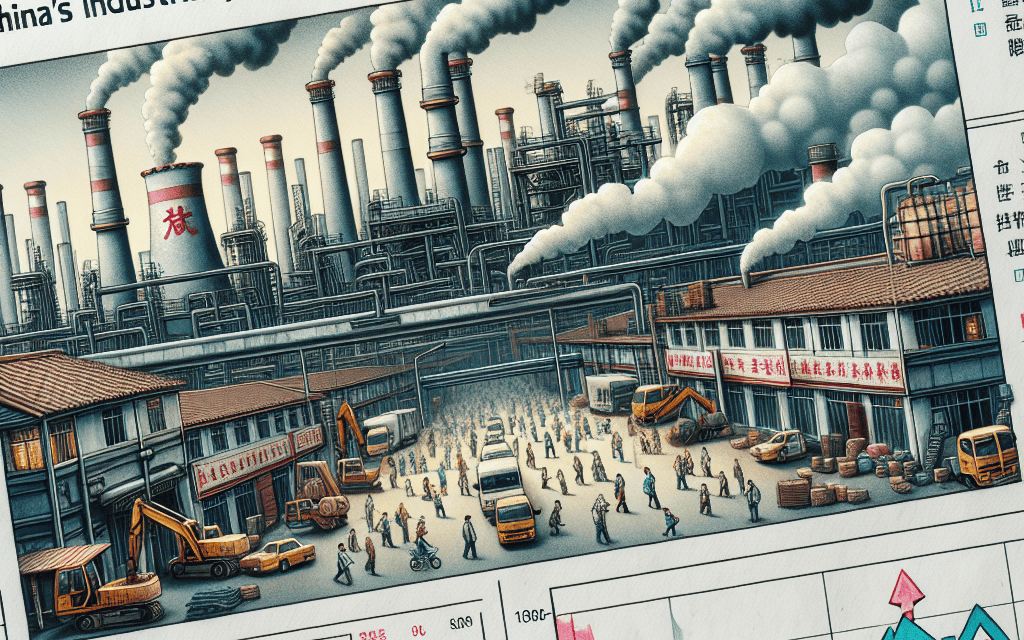“China’s Industrial Profits Plunge: Navigating the Deflation Dilemma”
Introduction
In recent months, China’s industrial sector has faced mounting challenges as profits continue to decline, exacerbated by the persistent impact of deflationary pressures. The world’s second-largest economy is grappling with a complex economic landscape, where sluggish domestic demand and global uncertainties have contributed to a downturn in industrial profitability. This decline underscores the broader economic challenges China faces, as it seeks to balance growth with stability in an increasingly volatile global market. The deflationary environment has not only affected pricing power but also squeezed margins across various industries, prompting concerns about the long-term implications for China’s economic trajectory and its role in the global supply chain.
Analysis Of China’s Industrial Profit Decline In 2023
In 2023, China’s industrial sector has faced significant challenges, with industrial profits continuing to decline amid the persistent impact of deflation. This downturn has raised concerns about the broader implications for the Chinese economy and its global trade relationships. To understand the factors contributing to this decline, it is essential to examine the interplay of domestic and international economic conditions, as well as the structural issues within China’s industrial landscape.
The decline in industrial profits can be attributed, in part, to the deflationary pressures that have gripped the Chinese economy. Deflation, characterized by falling prices, can lead to reduced revenue for companies as the value of their goods diminishes. This situation is exacerbated by the fact that many Chinese industries are heavily reliant on exports, making them vulnerable to fluctuations in global demand. As international markets experience their own economic challenges, the demand for Chinese goods has softened, further straining industrial profits.
Moreover, the Chinese government has implemented various policy measures aimed at stabilizing the economy, including monetary easing and fiscal stimulus. While these efforts have provided some relief, they have not been sufficient to counteract the deflationary trend. The effectiveness of these policies is limited by structural issues within the industrial sector, such as overcapacity and inefficiencies in production processes. These challenges have been longstanding, and despite efforts to address them, they continue to hinder the sector’s ability to adapt to changing economic conditions.
In addition to domestic factors, external influences have also played a significant role in the decline of industrial profits. The global economic environment has been marked by uncertainty, with geopolitical tensions and trade disputes affecting international trade flows. For instance, the ongoing trade tensions between China and the United States have led to tariffs and other trade barriers, which have disrupted supply chains and increased costs for Chinese manufacturers. These challenges have compounded the difficulties faced by the industrial sector, making it harder for companies to maintain profitability.
Furthermore, the transition towards a more sustainable and environmentally friendly economy has introduced additional pressures on China’s industrial sector. As the government pushes for greener production methods and stricter environmental regulations, companies are required to invest in new technologies and processes. While these changes are necessary for long-term sustainability, they can be costly in the short term, further squeezing profit margins.
Despite these challenges, there are opportunities for the industrial sector to adapt and thrive. Innovation and technological advancement can play a crucial role in enhancing productivity and efficiency. By investing in research and development, companies can develop new products and processes that meet changing consumer demands and reduce production costs. Additionally, expanding into emerging markets can help diversify revenue streams and reduce reliance on traditional export markets.
In conclusion, the decline in China’s industrial profits in 2023 is a multifaceted issue, influenced by both domestic and international factors. While deflationary pressures and structural inefficiencies pose significant challenges, there are pathways for recovery and growth. By addressing these issues through policy measures and strategic investments, China can bolster its industrial sector and ensure its continued contribution to the national economy. As the global economic landscape evolves, the ability of China’s industrial sector to adapt will be crucial in determining its future trajectory.
The Role Of Deflation In China’s Economic Slowdown
China’s industrial sector, a cornerstone of its economic prowess, has recently faced a significant downturn, with industrial profits declining further amid the pervasive impact of deflation. This economic phenomenon, characterized by a general decrease in prices, has far-reaching implications for the world’s second-largest economy. As deflationary pressures mount, they exacerbate existing challenges within China’s industrial landscape, leading to a slowdown that reverberates across global markets.
To understand the role of deflation in China’s economic slowdown, it is essential to first consider the underlying causes of this deflationary trend. A combination of factors, including weakened domestic demand, overcapacity in key industries, and global economic uncertainties, has contributed to a persistent decline in prices. As consumer spending falters and businesses struggle to maintain profitability, the industrial sector finds itself in a precarious position. This deflationary environment not only erodes profit margins but also discourages investment, as companies become hesitant to expand operations or innovate in the face of uncertain returns.
Moreover, deflation can lead to a vicious cycle of reduced spending and investment, further stalling economic growth. As prices continue to fall, consumers and businesses alike may delay purchases and investments, anticipating even lower prices in the future. This behavior, while rational on an individual level, collectively dampens economic activity, leading to a slowdown that is difficult to reverse. In China, where the industrial sector plays a pivotal role in driving economic growth, the impact of deflation is particularly pronounced. The decline in industrial profits serves as a stark indicator of the challenges facing the sector, as companies grapple with shrinking revenues and mounting financial pressures.
In addition to domestic factors, external influences also play a significant role in shaping China’s deflationary landscape. Global trade tensions, fluctuating commodity prices, and geopolitical uncertainties contribute to an environment of instability that further complicates the economic outlook. As a major player in international trade, China is particularly vulnerable to shifts in global demand and supply dynamics. The resulting volatility can exacerbate deflationary pressures, as export-oriented industries face declining orders and increased competition.
In response to these challenges, Chinese policymakers have implemented a range of measures aimed at stabilizing the economy and mitigating the impact of deflation. Monetary policy adjustments, such as interest rate cuts and liquidity injections, are designed to stimulate borrowing and spending. Additionally, fiscal policies, including infrastructure investments and tax incentives, aim to bolster domestic demand and support struggling industries. However, the effectiveness of these measures remains uncertain, as structural issues within the economy continue to pose significant obstacles to sustained growth.
Ultimately, addressing the root causes of deflation and revitalizing the industrial sector will require a multifaceted approach. Structural reforms, aimed at reducing overcapacity and enhancing productivity, are essential to fostering a more resilient and dynamic economy. Furthermore, efforts to boost consumer confidence and encourage private sector investment will be crucial in reversing the deflationary trend and reigniting economic momentum.
In conclusion, the decline in China’s industrial profits amid deflationary pressures underscores the complex interplay of domestic and global factors contributing to the country’s economic slowdown. As policymakers navigate this challenging landscape, the path to recovery will hinge on their ability to implement effective strategies that address both immediate concerns and long-term structural issues. The outcome of these efforts will not only shape China’s economic trajectory but also have significant implications for the global economy.
Key Sectors Affected By China’s Industrial Profit Drop
China’s industrial sector, a cornerstone of its economic prowess, has been experiencing a notable decline in profits, exacerbated by the persistent specter of deflation. This downturn is not only a reflection of the broader economic challenges facing the nation but also a signal of the pressures mounting on key sectors that have traditionally driven China’s growth. As the world’s second-largest economy grapples with these issues, understanding the specific sectors affected provides insight into the broader implications for both domestic and global markets.
The manufacturing sector, often regarded as the backbone of China’s industrial landscape, has been particularly hard hit. With deflationary pressures leading to falling prices, manufacturers are finding it increasingly difficult to maintain profit margins. This is compounded by rising input costs and a sluggish global demand, which have further squeezed profitability. As a result, many manufacturing firms are facing the dual challenge of managing costs while trying to stimulate demand in a competitive international market.
In tandem with manufacturing, the real estate sector is also experiencing significant strain. Once a robust driver of economic growth, the real estate market in China has been cooling, with property prices stagnating or even declining in some areas. This has led to reduced investment and development activity, impacting related industries such as construction and materials. The ripple effect of a slowing real estate market is profound, as it affects employment, consumer confidence, and ultimately, industrial profits.
Moreover, the energy sector is not immune to these challenges. China’s energy industry, which includes coal, oil, and renewable energy sources, is facing a complex set of circumstances. On one hand, the push for cleaner energy and reduced carbon emissions is reshaping the landscape, requiring significant investment in new technologies and infrastructure. On the other hand, traditional energy sectors are grappling with fluctuating global prices and regulatory changes, which have contributed to volatility in profits. This sector’s transformation is crucial for China’s long-term sustainability goals, yet it presents immediate financial hurdles.
Additionally, the technology sector, often seen as a beacon of innovation and growth, is encountering its own set of difficulties. While demand for technology products remains robust, the sector is not immune to the broader economic slowdown. Trade tensions, regulatory scrutiny, and supply chain disruptions have all played a role in dampening profit growth. Companies are being forced to navigate a complex landscape of geopolitical challenges while continuing to invest in research and development to maintain their competitive edge.
Furthermore, the automotive industry, a significant component of China’s industrial output, is also feeling the pinch. With consumer spending under pressure and a shift towards electric vehicles, traditional automakers are facing a period of transition. This shift requires substantial investment in new technologies and infrastructure, which can strain financial resources in the short term, even as it promises long-term benefits.
In conclusion, the decline in China’s industrial profits is a multifaceted issue that affects several key sectors. Each sector faces unique challenges, yet they are all interconnected within the broader economic framework. As China navigates these turbulent times, the strategies employed to address these challenges will be critical in determining the future trajectory of its industrial sector. The global economy, in turn, will be closely watching these developments, given China’s integral role in international trade and economic stability.
Government Measures To Counteract China’s Industrial Profit Decline

China’s industrial sector, a cornerstone of its economic prowess, has been facing significant challenges as industrial profits continue to decline. This downturn is largely attributed to the persistent deflationary pressures that have gripped the nation. In response, the Chinese government has been actively implementing a series of measures aimed at counteracting this decline and stabilizing the industrial landscape. These efforts are crucial not only for maintaining economic stability but also for ensuring the long-term growth and competitiveness of China’s industrial sector.
To begin with, the Chinese government has introduced fiscal policies designed to stimulate demand and invigorate industrial activity. Tax cuts and rebates have been implemented to alleviate the financial burden on businesses, thereby encouraging investment and production. By reducing the cost of doing business, these measures aim to enhance the profitability of industrial enterprises, which have been struggling to maintain margins in the face of falling prices. Furthermore, the government has increased its spending on infrastructure projects, which serves a dual purpose: boosting demand for industrial goods and providing a direct stimulus to the economy.
In addition to fiscal measures, monetary policy has also been adjusted to support industrial growth. The People’s Bank of China has lowered interest rates and reduced reserve requirements for banks, thereby increasing the availability of credit. This move is intended to facilitate easier access to financing for industrial firms, enabling them to invest in new technologies and expand their operations. By fostering an environment of low borrowing costs, the government hopes to spur industrial innovation and productivity, which are essential for reversing the profit decline.
Moreover, the Chinese government has been actively promoting structural reforms to enhance the efficiency and competitiveness of its industrial sector. These reforms include efforts to streamline regulations, reduce bureaucratic red tape, and improve the overall business environment. By creating a more conducive environment for industrial enterprises, the government aims to attract both domestic and foreign investment, which is vital for revitalizing the sector. Additionally, there is a strong emphasis on encouraging mergers and acquisitions to consolidate industries and eliminate excess capacity, which has been a significant factor contributing to deflationary pressures.
Another critical aspect of the government’s strategy is the promotion of technological innovation and the development of high-value industries. Recognizing the need to move up the value chain, China is investing heavily in research and development, particularly in areas such as artificial intelligence, renewable energy, and advanced manufacturing. By fostering innovation, the government seeks to create new growth drivers that can offset the decline in traditional industrial profits. This shift towards high-tech industries is expected to enhance the overall resilience and sustainability of China’s industrial sector.
Furthermore, the government is also focusing on expanding international trade partnerships to open new markets for Chinese industrial products. By participating in global trade initiatives and negotiating favorable trade agreements, China aims to increase its export opportunities, thereby providing a much-needed boost to its industrial sector. This strategy not only helps in diversifying market risks but also strengthens China’s position in the global supply chain.
In conclusion, the Chinese government’s multifaceted approach to counteracting the decline in industrial profits reflects a comprehensive strategy aimed at addressing both immediate challenges and long-term structural issues. Through a combination of fiscal and monetary policies, structural reforms, technological innovation, and international trade expansion, China is striving to stabilize its industrial sector and lay the groundwork for sustainable economic growth. As these measures take effect, it remains to be seen how successfully they will mitigate the impact of deflation and restore the vitality of China’s industrial landscape.
Global Implications Of China’s Industrial Profit Reduction
China’s industrial sector, a cornerstone of the global economy, has recently experienced a significant decline in profits, raising concerns about the broader implications for international markets. This downturn is largely attributed to the persistent deflationary pressures that have gripped the nation, creating a ripple effect that extends far beyond its borders. As the world’s second-largest economy, China’s economic health is intrinsically linked to global financial stability, and the current situation warrants a closer examination of its potential impact on international trade and investment.
To begin with, the decline in China’s industrial profits is a reflection of the broader economic challenges the country faces. Deflation, characterized by falling prices, has been a persistent issue, eroding profit margins for manufacturers and industrial firms. This phenomenon is not merely a domestic concern; it has significant implications for global supply chains. As Chinese companies struggle to maintain profitability, they may be forced to cut costs, reduce production, or even shutter operations. Such actions could disrupt the supply of goods worldwide, leading to shortages and increased prices in other countries.
Moreover, the reduction in industrial profits in China could have a dampening effect on global economic growth. China’s industrial sector is a major driver of its economic expansion, and any slowdown in this area can have a cascading effect on other sectors, both domestically and internationally. For instance, countries that rely heavily on exporting raw materials to China may experience decreased demand, leading to lower revenues and potential economic slowdowns. This interconnectedness underscores the importance of China’s industrial health to the global economy.
In addition to affecting trade, the decline in China’s industrial profits could also influence global investment patterns. Investors, wary of the risks associated with deflation and reduced profitability, may become more cautious about investing in Chinese industries. This hesitancy could lead to a reallocation of capital to other regions perceived as more stable or promising, potentially altering the landscape of global investment. Furthermore, multinational corporations with significant operations in China may need to reassess their strategies, considering the potential for reduced returns on investment.
The impact of China’s industrial profit decline is not limited to economic factors; it also has geopolitical implications. As China grapples with these economic challenges, its ability to exert influence on the global stage may be affected. A weakened industrial sector could limit China’s capacity to engage in large-scale infrastructure projects or provide financial assistance to other countries, thereby altering the dynamics of international relations. Additionally, other nations may view China’s economic struggles as an opportunity to strengthen their own positions in the global market, potentially leading to shifts in alliances and trade partnerships.
In conclusion, the decline in China’s industrial profits amid deflationary pressures is a multifaceted issue with far-reaching global implications. It highlights the interconnectedness of modern economies and the potential for domestic challenges to have international repercussions. As the world closely monitors China’s economic trajectory, it is essential for policymakers and business leaders to consider the broader impact of these developments and to prepare for potential shifts in trade, investment, and geopolitical dynamics. By understanding and addressing these challenges, the global community can work towards mitigating the risks associated with China’s industrial profit decline and fostering a more resilient and stable economic environment.
Historical Context: Comparing Past And Present Industrial Profit Trends In China
China’s industrial sector has long been a cornerstone of its economic prowess, driving growth and development over the past few decades. Historically, the country’s industrial profits have experienced significant fluctuations, often reflecting broader economic trends and policy shifts. In the late 20th century, China’s economic reforms and opening-up policies led to a surge in industrial activity, with profits soaring as the nation became a global manufacturing hub. This period of rapid industrialization was characterized by double-digit growth rates, fueled by foreign investment and a burgeoning export market.
However, as we transition into the present, the landscape of China’s industrial sector has evolved considerably. Recent data indicates a troubling decline in industrial profits, a trend that has been exacerbated by the impact of deflation. This decline is not merely a cyclical downturn but rather a reflection of deeper structural challenges facing the Chinese economy. The deflationary pressures have been particularly pronounced in sectors such as manufacturing and construction, where overcapacity and sluggish demand have led to falling prices and squeezed profit margins.
To understand the current situation, it is essential to compare it with past trends. In previous decades, China’s industrial sector benefited from a combination of low labor costs, favorable government policies, and a robust global demand for Chinese goods. These factors contributed to sustained profit growth, even during periods of global economic uncertainty. However, the present scenario is markedly different. Rising labor costs, trade tensions, and a shift towards a more consumption-driven economy have altered the dynamics of industrial profitability.
Moreover, the deflationary environment has compounded these challenges. Deflation, characterized by falling prices, can lead to reduced revenues for companies, as consumers and businesses delay purchases in anticipation of further price drops. This has created a vicious cycle, where declining profits lead to reduced investment and production, further exacerbating the deflationary spiral. In contrast to past periods of inflation-driven growth, the current deflationary pressures have stifled the industrial sector’s ability to rebound.
Additionally, the Chinese government’s efforts to transition the economy towards high-tech industries and services have also played a role in the shifting profit trends. While these sectors hold promise for future growth, the transition has been uneven, with traditional industries bearing the brunt of the adjustment costs. This has led to a bifurcation within the industrial sector, where some companies thrive while others struggle to adapt.
In response to these challenges, policymakers have implemented a range of measures aimed at stabilizing the industrial sector. These include monetary easing, fiscal stimulus, and targeted support for struggling industries. However, the effectiveness of these measures remains uncertain, as the underlying structural issues continue to pose significant hurdles.
In conclusion, the decline in China’s industrial profits amid deflationary pressures marks a significant departure from past trends. While historical factors such as rapid industrialization and favorable global conditions once drove profit growth, the current environment is shaped by a complex interplay of domestic and international challenges. As China navigates this new economic landscape, the ability to adapt and innovate will be crucial in reversing the downward trend and ensuring sustainable industrial growth in the future.
Future Outlook: Can China Reverse The Industrial Profit Decline?
China’s industrial sector, a cornerstone of its economic prowess, has been experiencing a notable decline in profits, exacerbated by the persistent specter of deflation. This downturn raises pressing questions about the future trajectory of China’s industrial landscape and whether the nation can effectively reverse this trend. As we delve into the potential future outlook, it is essential to consider the multifaceted factors contributing to this decline and the strategies that might be employed to counteract it.
To begin with, the decline in industrial profits can be attributed to several interrelated factors. The global economic slowdown has dampened demand for Chinese exports, a critical component of the country’s industrial output. Simultaneously, domestic challenges, such as rising labor costs and regulatory pressures, have further strained profit margins. Moreover, the deflationary environment, characterized by falling prices, has compounded these issues by eroding revenue streams and discouraging investment in the industrial sector.
In light of these challenges, the Chinese government has been proactive in implementing measures aimed at stabilizing the industrial sector. Monetary policy adjustments, such as interest rate cuts and increased liquidity injections, have been employed to stimulate economic activity. Additionally, fiscal policies, including tax cuts and infrastructure spending, have been designed to bolster domestic demand and support industrial growth. However, the effectiveness of these measures remains a subject of debate, as the structural issues underlying the profit decline persist.
Looking ahead, China’s ability to reverse the industrial profit decline will likely hinge on its capacity to adapt to a rapidly changing global economic landscape. One potential avenue for revitalization lies in the pursuit of technological innovation and the transition towards high-value manufacturing. By investing in research and development, China can enhance its competitive edge and reduce its reliance on low-cost manufacturing, which has been increasingly challenged by other emerging economies.
Furthermore, the expansion of domestic consumption presents another opportunity for growth. As China’s middle class continues to expand, there is significant potential for increased demand for domestically produced goods. Encouraging consumer spending through targeted policies and improving income distribution could help offset the decline in export-driven industrial profits.
In addition to these strategies, fostering international cooperation and trade partnerships could provide a much-needed boost to China’s industrial sector. By engaging in multilateral trade agreements and reducing trade barriers, China can access new markets and diversify its export base, thereby mitigating the impact of global economic fluctuations.
Nevertheless, the path to reversing the industrial profit decline is fraught with challenges. The ongoing trade tensions with major economies, particularly the United States, pose a significant risk to China’s export-oriented industries. Moreover, the transition towards a more sustainable and environmentally friendly industrial model may require substantial investments and policy adjustments, which could further strain short-term profitability.
In conclusion, while the decline in China’s industrial profits presents a formidable challenge, it also offers an opportunity for transformation and growth. By embracing innovation, expanding domestic consumption, and fostering international cooperation, China can potentially reverse this trend and secure a more resilient and sustainable industrial future. However, achieving this will require a delicate balance of policy interventions, strategic investments, and a commitment to addressing both domestic and global economic challenges. As China navigates this complex landscape, the world will be closely watching to see how it adapts and evolves in the face of adversity.
Q&A
1. **What is the current trend in China’s industrial profits?**
China’s industrial profits are experiencing a decline.
2. **What economic factor is contributing to the decline in industrial profits?**
Deflation is a significant factor contributing to the decline.
3. **How does deflation impact industrial profits?**
Deflation can lead to lower prices for goods, reducing revenue and profit margins for industries.
4. **Which sectors are most affected by the decline in industrial profits?**
Manufacturing and heavy industries are often most affected by declines in industrial profits.
5. **What are the potential long-term effects of continued industrial profit decline?**
Long-term effects may include reduced investment, layoffs, and slower economic growth.
6. **What measures might the Chinese government take to address this issue?**
The government might implement monetary easing, fiscal stimulus, or policy reforms to boost demand and stabilize prices.
7. **How does the decline in industrial profits affect global markets?**
It can lead to reduced demand for raw materials and exports, impacting global supply chains and economic growth.
Conclusion
China’s industrial profits have continued to decline, exacerbated by the ongoing deflationary pressures within the economy. This trend reflects the challenges faced by Chinese industries, including reduced consumer demand, falling producer prices, and global economic uncertainties. The deflationary environment has led to decreased revenue and profit margins for manufacturers, impacting overall economic growth. Additionally, the decline in industrial profits signals potential long-term implications for investment and employment within the sector. To counteract these effects, policymakers may need to implement measures to stimulate demand, stabilize prices, and support industrial growth to ensure sustainable economic recovery.





